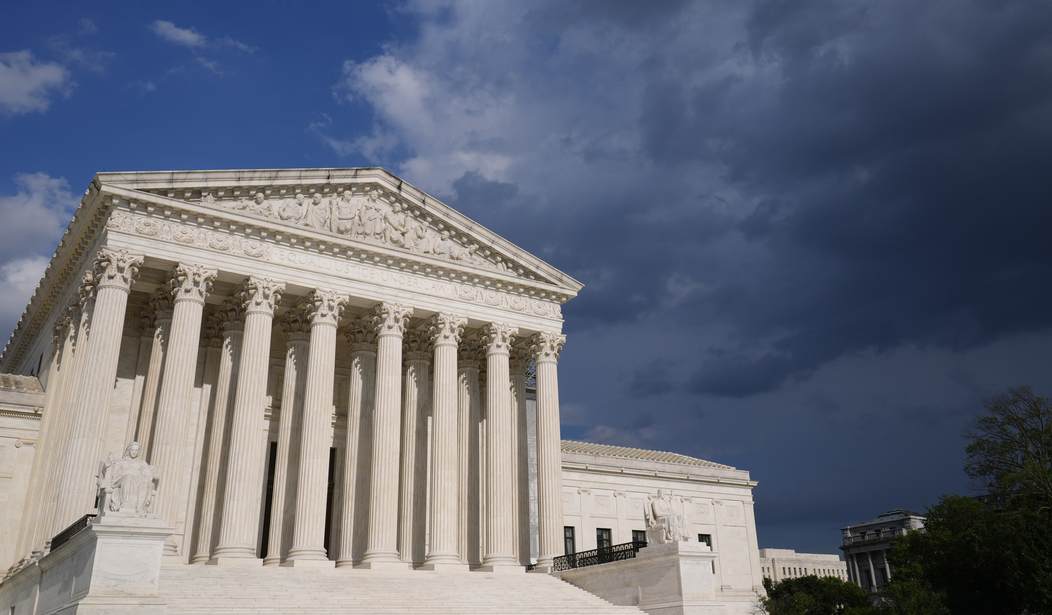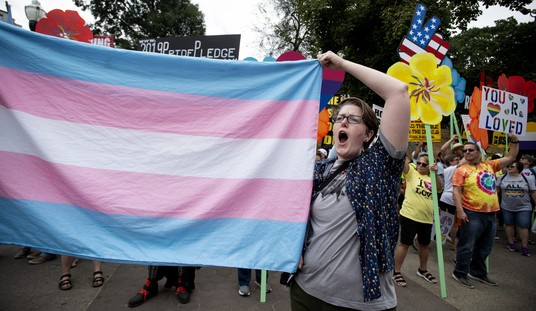Nearly ever since the Supreme Court ruled in favor of same-sex marriage in Obergefell, Democrats have used the case to claim that Donald Trump would work to overturn it. Never mind that Trump has never suggested that he viewed same-sex marriage as an issue to oppose; never mind that Trump had served a full term without attempting to disturb the 2015 ruling.
Every single election, Democrats trot out the "Trump is a danger to same-sex marriage" argument. The demise of Roe v Wade in 2022's Dobbs decision only ramped up that rhetoric, arguing that the Trump appointees to the Supreme Court would demolish the precedent in Obergefell at their next opportunity.
The next opportunity arrived today, and to no rational person's surprise, the Supreme Court tossed it aside. Not even four justices showed any interest in revisiting the issue of same-sex marriage:
The Supreme Court on Monday turned down a request that it consider overturning its landmark decision to legalize same-sex marriage a decade ago.
The court, without comment, declined the petition, filed by Kim Davis, a former Kentucky county clerk who gained national attention in 2015 when she defied a court order and refused to issue same-sex licenses because of her religious beliefs.
She had asked the Supreme Court to reverse an order that required her to pay more than $300,000 to a couple denied a marriage license — and to overturn the same-sex marriage ruling from 2015.
It takes four justices to accept a case for review, or to grant certiorari, in the court's lingo. Trump appointed three of the current justices on the Supreme Court: Neil Gorsuch, Brett Kavanaugh, and Amy Coney Barrett. Two other conservatives predate their appointment: Clarence Thomas and Samuel Alito, neither of whom can be described as a slave to stare decisis. This is the same panel that overturned Roe, after all, just three years ago. And yet, despite that 6-3 decision, the same court couldn't find four justices interested in revisiting Obergefell.
That didn't stop the New York Times from mentioning the Chicken Little demagoguery:
Still, the justices’ consideration of Ms. Davis’s petition had set off alarms among gay Americans, who were already reeling from the Trump administration’s targeting of programs and funding that benefit L.G.B.T.Q. individuals.
Gay Americans and their allies had been on alert since the Supreme Court’s conservative majority eliminated the nationwide right to abortion after 50 years, showing a willingness to undo longstanding legal precedent.
In fairness, as the NYT points out, Thomas did advise the court to use its logic in Dobbs to rethink Obergefell. The combined decision, concurrences, and dissents contain 28 mentions of Obergefell v Hodges, however, and most of those dispense with the notion that the issues are related. In fact, the main opinion in Dobbs rejects that approach entirely:
Respondents and the Solicitor General also rely on post-Casey decisions like Lawrence v. Texas, 539 U. S. 558 (2003) (right to engage in private, consensual sexual acts), and Obergefell v. Hodges, 576 U. S. 644 (2015) (right to marry a person of the same sex). See Brief for Respondents 18; Brief for United States 23–24.
These attempts to justify abortion through appeals to a broader right to autonomy and to defne one's “concept of existence” prove too much. Casey, 505 U. S., at 851. Those criteria, at a high level of generality, could license fundamental rights to illicit drug use, prostitution, and the like. See Compassion in Dying v. Washington, 85 F. 3d 1440, 1444 (CA9 1996) (O'Scannlain, J., dissenting from denial of rehearing en banc). None of these rights has any claim to being deeply rooted in history. Id., at 1440, 1445.
What sharply distinguishes the abortion right from the rights recognized in the cases on which Roe and Casey rely is something that both those decisions acknowledged: Abortion destroys what those decisions call “potential life” and what the law at issue in this case regards as the life of an “unborn human being.” See Roe, 410 U. S., at 159 (abortion is “inherently different”); Casey, 505 U. S., at 852 (abortion is “a unique act”). None of the other decisions cited by Roe and Casey involved the critical moral question posed by abortion. They are therefore inapposite. They do not support the right to obtain an abortion, and by the same token, our conclusion that the Constitution does not confer such a right does not undermine them in any way.
In fact, the 6-3 majority opinion explicitly warned that the considerations in Dobbs did not apply to Obergefell. The dissenters raised the specter of unlimited destruction of social-justice precedents, and the majority responded:
The most striking feature of the dissent is the absence of any serious discussion of the legitimacy of the States' interest in protecting fetal life. This is evident in the analogy that the dissent draws between the abortion right and the rights recognized in Griswold (contraception), Eisenstadt (same), Lawrence (sexual conduct with member of the same sex), and Obergefell (same-sex marriage). Perhaps this is designed to stoke unfounded fear that our decision will imperil those other rights, but the dissent's analogy is objectionable for a more important reason: what it reveals about the dissent's views on the protection of what Roe called “potential life.” The exercise of the rights at issue in Griswold, Eisenstadt, Lawrence, and Obergefell does not destroy a “potential life,” but an abortion has that effect. So if the rights at issue in those cases are fundamentally the same as the right recognized in Roe and Casey, the implication is clear: The Constitution does not permit the States to regard the destruction of a “potential life” as a matter of any signifcance.
That view is evident throughout the dissent. The dissent has much to say about the effects of pregnancy on women, the burdens of motherhood, and the diffculties faced by poor women. These are important concerns. However, the dissent evinces no similar regard for a State's interest in protecting prenatal life.
Is it possible that four of these six justices would change their minds three years later? Maybe, but they didn't. They made their reasons as clear as possible in the Dobbs ruling. Underlying it, though, is the very real truth that Roe was a judicial atrocity from the start, an attempt to legislate an issue for which the Constitution gave no authority to the federal government. The court alluded to that numerous times in the main opinion, especially here:
Roe was on a collision course with the Constitution from the day it was decided, Casey perpetuated its errors, and those errors do not concern some arcane corner of the law of little importance to the American people. Rather, wielding nothing but “raw judicial power,” Roe, 410 U. S., at 222 (White, J., dissenting), the Court usurped the power to address a question of profound moral and social importance that the Constitution unequivocally leaves for the people. Casey described itself as calling both sides of the national controversy to resolve their debate, but in doing so, Casey necessarily declared a winning side. Those on the losing side—those who sought to advance the State's interest in fetal life—could no longer seek to persuade their elected representatives to adopt policies consistent with their views. The Court short-circuited the democratic process by closing it to the large number of Americans who dissented in any respect from Roe. “Roe fanned into life an issue that has infamed our national politics in general, and has obscured with its smoke the selection of Justices to this Court in particular, ever since.” Casey, 505 U. S., at 995–996 (opinion of Scalia, J.). Together, Roe and Casey represent an error that cannot be allowed to stand.
One could make the same argument about Obergefell, as Thomas did. However, in Obergefell, the plaintiffs raised 14th Amendment concerns over the application of state laws forbidding same-sex couples to legally marry, as well as "full faith and credit" issues when couples in one state that recognized the marriage travel or move to other states. That had implications for federal benefits as well. It was still possible for the Supreme Court to rule in the other direction in Obergefell and to leave those issues to the states and to their voters, but their decision had much more foundation in both constitutional law and in jurisdiction than Roe ever did.
For these reasons, no one who read Dobbs ever took the idea that the Supreme Court would overturn their ruling in Obergefell seriously. Trump could replace the remaining justices on the Left, and they still won't touch it. There is almost no societal pressure to rethink same-sex marriage at this point, which means that challenges to it have all but evaporated. This one case is a relic from the immediate aftermath of Obergefell. There will be few, if any, occasions to revisit that ruling in the future.
In other words, this has been a moot topic for three years -- except for Democrat demagogues who keep it alive as a fundraising and organizing message. That makes the Chicken Little Left the hardest hit by this denial of cert ... with the Protection Racket Media a close second.
Addendum: My pal and colleague Guy Benson takes an I told you so lap:
—> Now that SCOTUS has officially declined to revisit same-sex marriage, I’m appealing to the many people who sent me articles & tweets about how Obergefell might be doomed, then scoffed when I responded with sound analysis: Please consider who was correct & who was scaring you… pic.twitter.com/qg4kuTgj30
— Guy Benson (@guypbenson) November 10, 2025
Here's the link to his lengthy argument from almost exactly a year ago that predicted this outcome.








